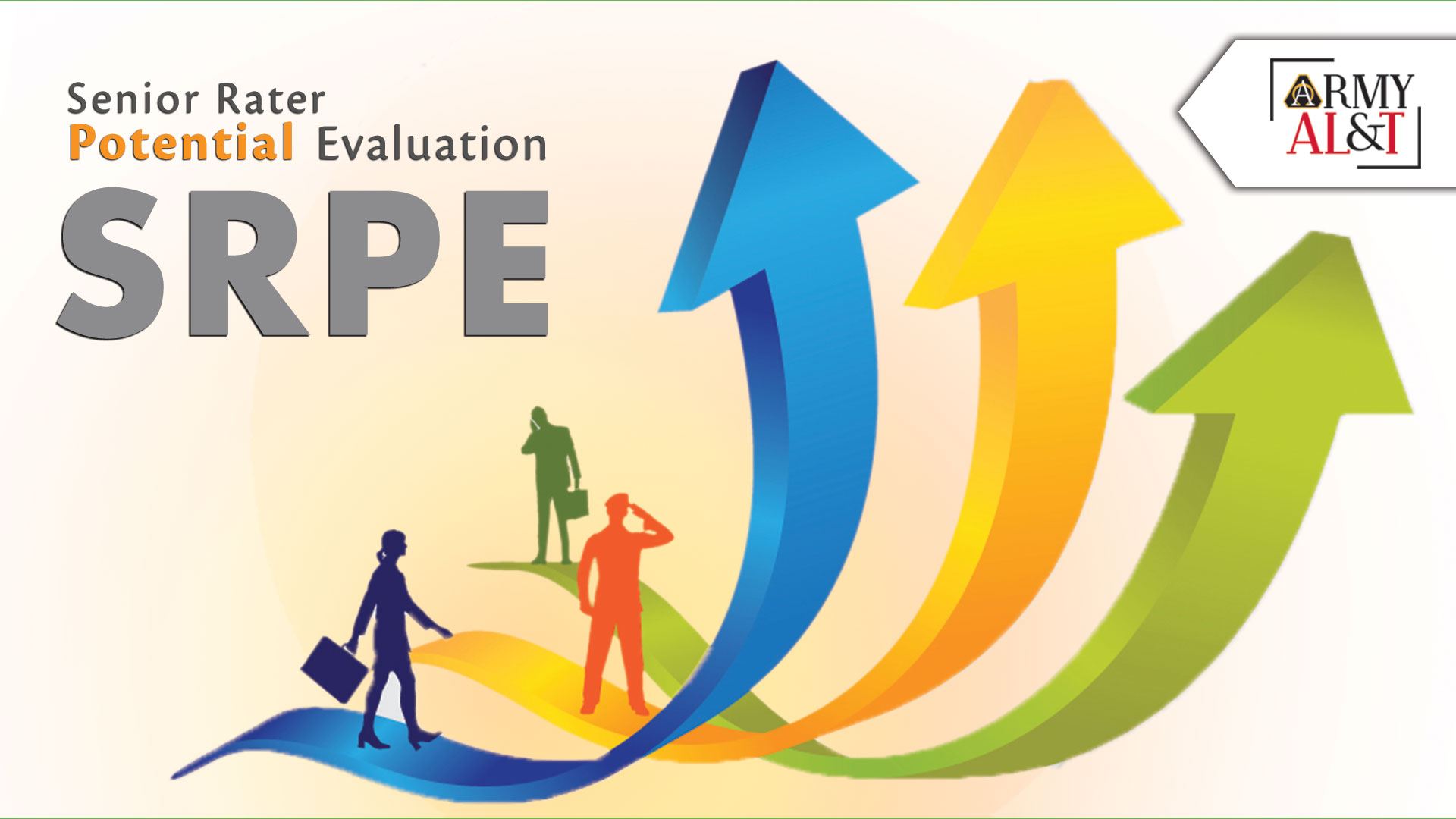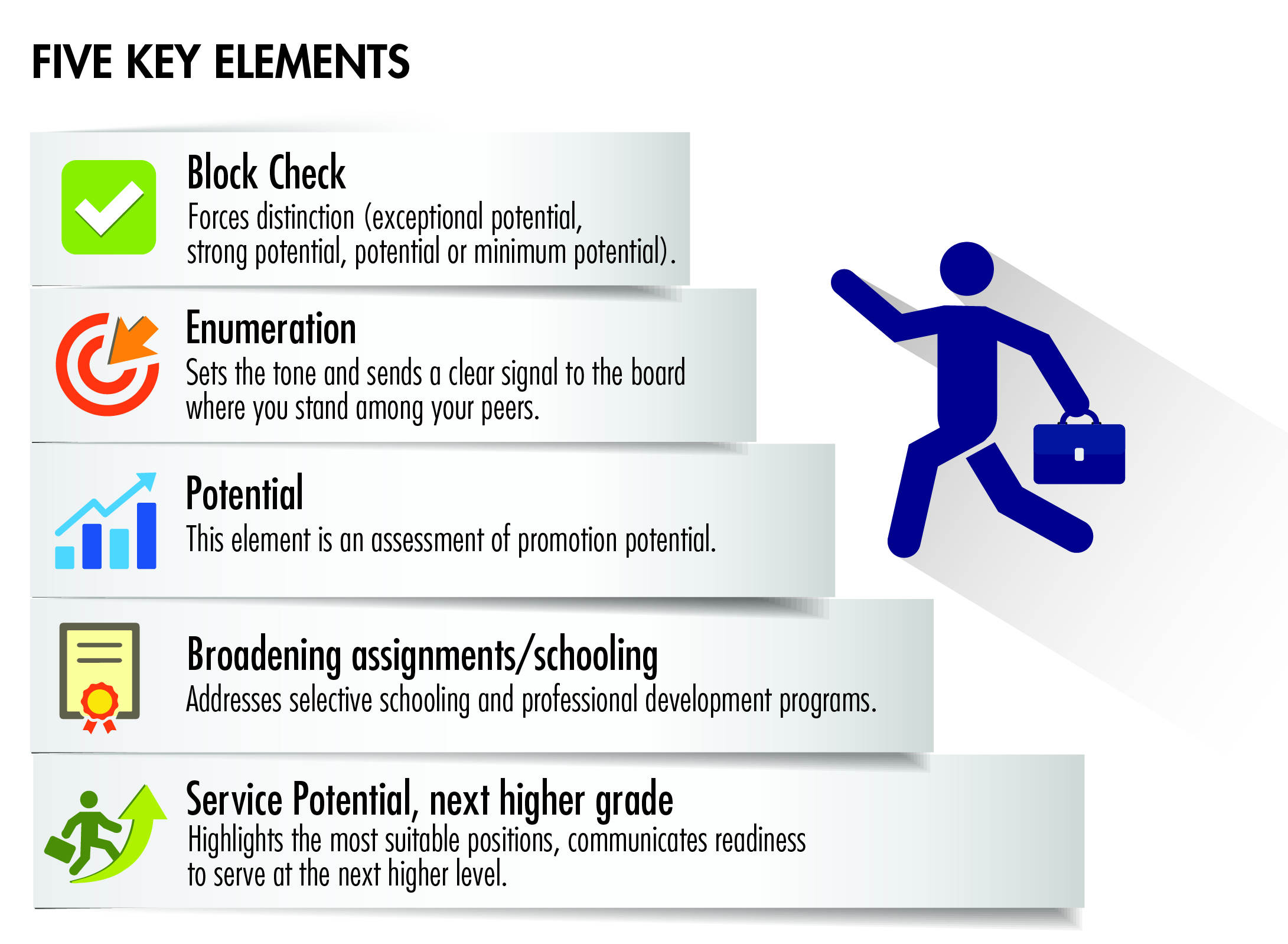
ONWARD AND UPWARD: The SRPE is forward-looking, an assessment of the potential for civilian acquisition professionals to perform in positions of increased responsibility, based on their demonstrated leadership skills. In that respect, it differs from a performance appraisal, which looks back at what a person has accomplished or contributed in their current job. (Images by U.S. Army Acquisition Support Center)
Senior Rater Potential Evaluations help identify future leaders.
by Jacqueline M. Hames
The Senior Rater Potential Evaluation (SRPE) period is fast approaching—time for acquisition civilians to think about their future and potential as up-and-coming acquisition leaders. Since 2015, the SRPE has been required annually for Army Acquisition Workforce professionals GS-12 through GS-15 and pay band equivalent. Evaluations cover Oct. 1 through Sept. 30, and senior raters must complete the SRPE by Dec. 31.
So, what is SRPE? It is a talent management and employee development tool that can help supervisors identify future leaders. The SRPE assists leaders of civilian acquisition professionals to assess their potential to perform in or assume positions of increased responsibility, Norm Hilton, chief of the Army Acquisition Workforce Engagement Branch, explained. The Engagement Branch is part of the Director, Acquisition Career Management Office.
THE HISTORY
SRPE was developed in response to the need for a qualified and professional Defense Acquisition Workforce. In particular, Section 1733(a) of the Defense Acquisition Workforce Improvement Act requires that the best-qualified individuals be selected for acquisition leadership positions. The SRPE provides documentation of the leadership potential of civilian employees and allows selection boards to more easily and equitably compare civilian and military candidates, ensuring that the best person is selected for a leadership position.
In the April 2018 issue of the DACM Newsletter, Hilton gave a breakdown of how to assemble a SRPE and why it’s critical to central selection board screenings. A central selection board is group of people that evaluates a candidate’s eligibility for a leadership position using his or her career’s entire body of work. The SRPE “is the primary tool used to document and communicate a candidate’s potential and readiness to assume positions of increased responsibility. If done right, it will send a definitive message to the board that eliminates any guesswork,” he wrote. In other words, SRPEs allow the board to see a candidate’s skills and knowledge so the board can make an informed selection for an open leadership position. Some of the key take-aways Hilton highlighted are:
- Always use clear, quantifiable descriptions.
- Use short senior rater narratives and focus on enumeration (a sentence that sets the tone of the evaluation), potential for assuming increased responsibility, promotion, schooling and future assignment. It is not how much the senior rater writes that is important but the content of what is written.
- Include a duty description, senior rater narrative and number of employees at the equivalent grade being senior rated.
THE PROCESS
The evaluation process involves three people: the employee, the rater and the senior rater. “Historically, a rater is the person that supervises the individual,” said Brian Cole, SRPE program manager. “The senior rater is the supervisor’s supervisor. However, it can change depending on how the organizations are aligned.” For example, the program management office may direct the deputy program manager to be the senior rater for all the GS-14s, while the program executive officer is the senior rater for the GS-15s.
The rater or supervisor may initiate a request for a SRPE for any civilian acquisition professional under their direct supervision. Employees review and provide a signature once the evaluation is completed. “The senior rater completes the SRPEs of their subordinates at the request of the employee’s supervisor or annually for employees mandated by policy,” Cole said. The rater and senior rater also provide a digital signature on the completed SRPE.
While the SRPE process is similar to a performance appraisal, it is distinctly different, Cole explained. “A performance evaluation … depicts what individuals have accomplished or how they have contributed to [their] current position. A SRPE is designed to define your ability to receive increased responsibility—so that means your potential leadership skills in your position,” he said. Meaning that a performance evaluation catalogs accomplishments, while the SRPE helps determine what an individual is capable of doing if selected for leadership. During a performance appraisal, employees should not be discussing their potential, just as in an SRPE they should not be discussing their performance, Cole added.
The two processes share a common trait: open dialogue between the employee and the rater. Raters and employees have honest and frank discussions with their supervisors, Hilton said, often centered on their individual development plan, which serves as a base document in both the SRPE and performance appraisal. “There should be no surprises,” he said.

DISTINGUISH YOURSELF: By focusing on five key elements of the SRPE, Army acquisition professionals can maximize their potential for competitive advancement to high-level positions of leadership and responsibility. The SRPE is a tool to give selection boards the information they need on Army Acquisition Workforce civilians to clearly and equitably compare civilian and military candidates, ultimately ensuring that they choose the best person for the job. (Images by U.S. Army Acquisition Support Center)
THE RESOURCES
There are many reference documents on the website that can be pulled if people have questions, Hilton said. Employees, raters and senior raters can find policies and guidance, videos, instructional briefings and a user manual on the website at: https://asc.army.mil/web/senior-rater-potential-evaluation/. Acquisition civilians who are experiencing the SRPE evaluation process for the first time should check out the live training tutorial within the SRPE module at: https://apps.asc.army.mil/camp/.
If you’re ever in need of an SRPE quick-reference, the SRPE Supervisor Reference Guide is perfect—go to:
https://spcs3.kc.army.mil/asaalt/USAASC/USAASC%20Document%20Library/SRPE%20Supervisor%20Reference%20Guide.pdf#search=srpe%20reference%20guide.
For a deep dive, or if you just haven’t found the right information yet, check out the FAQ section on the USAASC website. Filter for “SRPE” at: https://asc.army.mil/web/all-faqs/.
For more information, contact Brian Cole at brian.k.cole2.civ@mail.mil.
JACQUELINE M. HAMES is an editor with Army AL&T magazine. She hold a B.A. in creative writing from Christopher Newport University. She has more than 10 years of experience writing and editing news and feature articles for publication.
Subscribe to Army AL&T News – the premier online news source for the Army Acquisition Workforce. ![]() Subscribe
Subscribe







